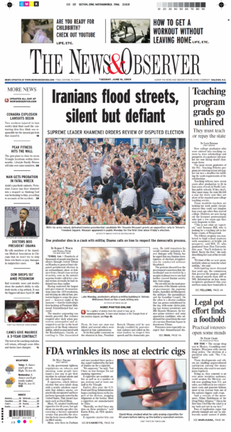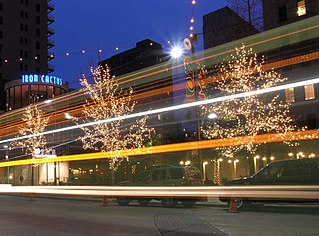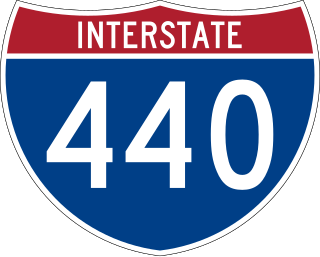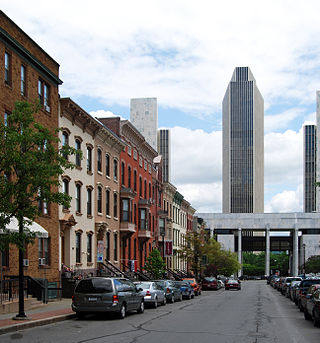
Raleigh is the capital city of the U.S. state of North Carolina and the seat of Wake County. It is the second-most populous city in North Carolina, after Charlotte. Raleigh is the tenth-most populous city in the Southeast, the 41st-most populous city in the U.S., and the largest city of the Research Triangle metro area. Raleigh is known as the "City of Oaks" for its many oak trees, which line the streets in the heart of the city. The city covers a land area of 148.54 square miles (384.7 km2). The U.S. Census Bureau counted the city's population as 467,665 at the 2020 census. It is one of the fastest-growing cities in the United States. The city of Raleigh is named after Sir Walter Raleigh, who established the now-lost Roanoke Colony in present-day Dare County.

Durham is a city in the U.S. state of North Carolina and the county seat of Durham County. Small portions of the city limits extend into Orange County and Wake County. With a population of 283,506 in the 2020 census, Durham is the 4th-most populous city in North Carolina, and the 71st-most populous city in the United States. The city is located in the east-central part of the Piedmont region along the Eno River. Durham is the core of the four-county Durham-Chapel Hill, NC Metropolitan Statistical Area, which had an estimated population of 608,879 in 2023. The Office of Management and Budget also includes Durham as a part of the Raleigh-Durham-Cary, NC Combined Statistical Area, commonly known as the Research Triangle, which had an estimated population of 2,368,947 in 2023.

PNC Arena is an indoor arena located in Raleigh, North Carolina. The arena seats 18,700 for ice hockey and 19,500 for basketball, including 61 suites, 13 luxury boxes and 2,000 club seats. The building has three concourses and a 300-seat restaurant.

The News & Observer is an American regional daily newspaper that serves the greater Triangle area based in Raleigh, North Carolina. The paper is the largest in circulation in the state. The paper has been awarded three Pulitzer Prizes, the most recent of which was in 1996 for a series on the health and environmental impact of North Carolina's booming hog industry. The paper was one of the first in the world to launch an online version of the publication, Nando.net in 1994.

Minneapolis is officially defined by its city council as divided into 83 neighborhoods. The neighborhoods are historically grouped into 11 communities. Informally, there are city areas with colloquial labels. Residents may also group themselves by their city street suffixes: North, Northeast, South, and Southeast.

The Main Street District of downtown Dallas, Texas runs along Main Street and is bounded by Elm Street one block north, Commerce St. one block south, N. Lamar St. to the west, and US 75/I-45 (I-345) elevated highway to the east. The district is the spine of downtown Dallas, and connects many of the adjoining business and entertainment districts. It does not include Dealey Plaza or the John Fitzgerald Kennedy Memorial which are a few blocks west in the West End Historic District.

Interstate 440 (I-440), also known as the Raleigh Beltline, the Cliff Benson Beltline, or locally as The Beltline, is an Interstate Highway in the US state of North Carolina. I-440 is a 16.4-mile-long (26.4 km) partial beltway that nearly encircles central Raleigh. I-440 begins in west Raleigh at an interchange with I-40 as a continuation of U.S. Highway 64 (US 64)/US 1 and traverses a primarily residential area in west Raleigh. The freeway makes a turn toward the east, crossing US 70, Six Forks Road, and Wake Forest Road. US 1 branches north off I-440 at US 401, becoming US 401/US 1. I-440 turns toward the southeast and follows a brief concurrency with U.S. Highway 64 Business before intersecting I-87/US 64/US 264. US 64 and I-87 are concurrent with I-440 along the remainder of the road's southwesterly routing. Exit 16 is the last exit on I-440, where I-440 splits to join either I-40 eastbound or I-40 westbound.

Downtown Atlanta is the central business district of Atlanta, Georgia, United States. The largest of the city's three commercial districts, it is the location of many corporate and regional headquarters; city, county, state, and federal government facilities; Georgia State University; sporting venues; and most of Atlanta's tourist attractions. It measures approximately four square miles, and had 26,850 residents as of 2017. Similar to other central business districts in the United States, it has recently undergone a transformation that includes the construction of new condos and lofts, renovation of historic buildings, and arrival of new residents and businesses.

Fayetteville Street is a major street in downtown Raleigh, North Carolina, United States of America. It is a north-south thoroughfare that connects the State Capitol to the Raleigh Convention Center and the Progress Energy Center for the Performing Arts. It is the City of Raleigh's ceremonial center, hosting parades, special events, and seasonal celebrations.

Village District, was the first planned community to be developed in Raleigh, North Carolina. Development was started in 1947 when J.W. York and R.A Bryan bought 158 acres (64 ha) of undeveloped land two miles west of downtown Raleigh, near the North Carolina State University campus. The "village" was to consist of a shopping center, apartments, and single family homes. The area was renamed to Village District in 2021 to distance itself from the slave owning Cameron family, who owned Stagville Plantation, that it was originally named after.
Glenwood or the Glenwood–Brooklyn Historic District is a historic neighborhood and national historic district located at Raleigh, North Carolina. The district encompasses 286 contributing buildings in an early-20th century streetcar suburb for working- and middle-class whites. Glenwood and Brooklyn were developed between about 1905 to 1951 and includes notable examples of Colonial Revival, Queen Anne, and Bungalow / American Craftsman style architecture. The houses are predominantly 1 1/2- and 2-story frame dwellings.

The Arts & Entertainment District, or previously known as Omni, is a neighborhood of Downtown Miami, Florida. It is bound roughly by North 19th Street to the north, North 10th Street to the south, North West 2nd Avenue to the west, and Biscayne Boulevard to the east.
Raleigh Downtown Live was a free summer concert series held in Raleigh, North Carolina, United States, in Moore Square Park, in the Moore Square Historic District of downtown from 2005 to 2009. It featured many top music artists from around the world, drawing over 70,000 music fans annually. It was a joint partnership between the City of Raleigh Convention Center and Deep South Entertainment of Raleigh, North Carolina. Deep South Entertainment continues to be based in downtown Raleigh, NC, with a second office in Nashville, TN. Deep South Entertainment currently produces the Oak City 7 summer concert series in Downtown Raleigh.

Capital Bank Financial Corporation was a bank holding company headquartered in Charlotte, North Carolina with $10 billion in assets as of first quarter 2017 and 193 branches. Former Bank of America vice chairman Gene Taylor was chief executive, former Bank of America executive and Fifth Third Bank CFO, Chris Marshall was CFO and former Bank of America executive, R. Bruce Singletary was Chief Risk Officer. Former Morgan Stanley specialty finance research analyst, Kenneth Posner, managed corporate strategy and investor relations. North American Financial Holdings (NAFH) original purpose was to take over banks that had difficulties due to the financial crisis of 2007–2010. The company's main interest was banks in the Carolinas and Florida, but in 2011, NAFH moved into Tennessee and Virginia. Despite buying seven distressed, money losing banks, NAFH's Capital Bank was consistently profitable during the duration of its existence and consistently posted improved returns for each of its five years of operations. Capital Bank completed a successful IPO in September 2012, and used to trade on the NASDAQ under the ticker CBF until its acquisition by First Horizon National Corporation in December 2017.

The architecture of Albany, New York, embraces a variety of architectural styles ranging from the early 18th century to the present. The city's roots date from the early 17th century and few buildings survive from that era or from the 18th and early 19th century. The completion of the Erie Canal in 1825 triggered a building boom, which continued until the Great Depression and the suburbanization of the area afterward. This accounts for much of the construction in the city's urban core along the Hudson River. Since then most construction has been largely residential, as the city spread out to its current boundaries, although there have been some large government building complexes in the modernist style, such as Empire State Plaza, which includes the Erastus Corning Tower, the tallest building in New York outside of New York City.

333 Fayetteville Street is a skyscraper in Raleigh, North Carolina which houses the headquarters of Capital Bank. Formerly known as 333 Corporate Plaza and Capital Bank Plaza, the 15-story building at 333 Fayetteville Street has 135,000 square feet (12,500 m2) of space and is an "outstanding example of International Style modernism" and "features black granite on the facade with polished green marble, black granite, and cherry paneling in the lobby."

Maitland station is a SunRail commuter rail station in Maitland, Florida. The station is located on the west side of Orlando Avenue along the former CSX A-Line. It is 1⁄4 mile (0.40 km) south of Maitland Boulevard and 1⁄2 mile (0.80 km) north of Maitland's downtown district, City Centre. It is the northernmost SunRail station in Orange County.
















